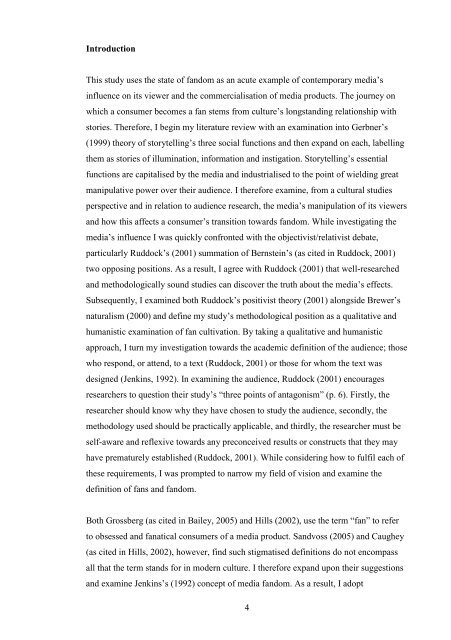The Case Study of Sherlock Holmes (2009) - Scholarly Commons ...
The Case Study of Sherlock Holmes (2009) - Scholarly Commons ...
The Case Study of Sherlock Holmes (2009) - Scholarly Commons ...
You also want an ePaper? Increase the reach of your titles
YUMPU automatically turns print PDFs into web optimized ePapers that Google loves.
Introduction<br />
This study uses the state <strong>of</strong> fandom as an acute example <strong>of</strong> contemporary media‟s<br />
influence on its viewer and the commercialisation <strong>of</strong> media products. <strong>The</strong> journey on<br />
which a consumer becomes a fan stems from culture‟s longstanding relationship with<br />
stories. <strong>The</strong>refore, I begin my literature review with an examination into Gerbner‟s<br />
(1999) theory <strong>of</strong> storytelling‟s three social functions and then expand on each, labelling<br />
them as stories <strong>of</strong> illumination, information and instigation. Storytelling‟s essential<br />
functions are capitalised by the media and industrialised to the point <strong>of</strong> wielding great<br />
manipulative power over their audience. I therefore examine, from a cultural studies<br />
perspective and in relation to audience research, the media‟s manipulation <strong>of</strong> its viewers<br />
and how this affects a consumer‟s transition towards fandom. While investigating the<br />
media‟s influence I was quickly confronted with the objectivist/relativist debate,<br />
particularly Ruddock‟s (2001) summation <strong>of</strong> Bernstein‟s (as cited in Ruddock, 2001)<br />
two opposing positions. As a result, I agree with Ruddock (2001) that well-researched<br />
and methodologically sound studies can discover the truth about the media‟s effects.<br />
Subsequently, I examined both Ruddock‟s positivist theory (2001) alongside Brewer‟s<br />
naturalism (2000) and define my study‟s methodological position as a qualitative and<br />
humanistic examination <strong>of</strong> fan cultivation. By taking a qualitative and humanistic<br />
approach, I turn my investigation towards the academic definition <strong>of</strong> the audience; those<br />
who respond, or attend, to a text (Ruddock, 2001) or those for whom the text was<br />
designed (Jenkins, 1992). In examining the audience, Ruddock (2001) encourages<br />
researchers to question their study‟s “three points <strong>of</strong> antagonism” (p. 6). Firstly, the<br />
researcher should know why they have chosen to study the audience, secondly, the<br />
methodology used should be practically applicable, and thirdly, the researcher must be<br />
self-aware and reflexive towards any preconceived results or constructs that they may<br />
have prematurely established (Ruddock, 2001). While considering how to fulfil each <strong>of</strong><br />
these requirements, I was prompted to narrow my field <strong>of</strong> vision and examine the<br />
definition <strong>of</strong> fans and fandom.<br />
Both Grossberg (as cited in Bailey, 2005) and Hills (2002), use the term “fan” to refer<br />
to obsessed and fanatical consumers <strong>of</strong> a media product. Sandvoss (2005) and Caughey<br />
(as cited in Hills, 2002), however, find such stigmatised definitions do not encompass<br />
all that the term stands for in modern culture. I therefore expand upon their suggestions<br />
and examine Jenkins‟s (1992) concept <strong>of</strong> media fandom. As a result, I adopt<br />
4

















